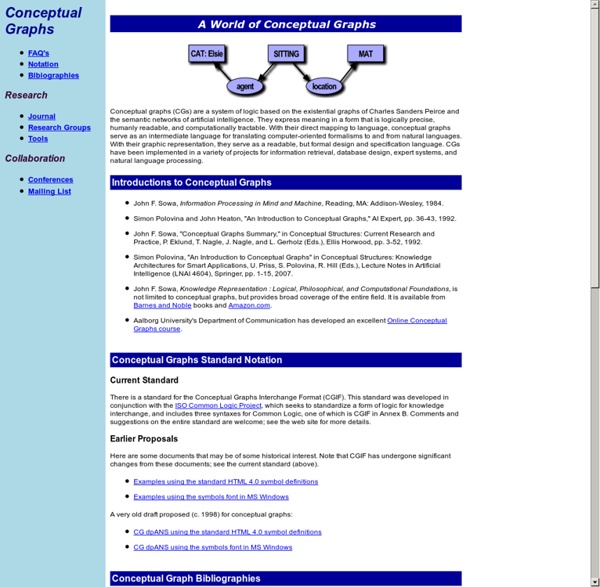



Formal Concept Analysis Homepage Formal Concept Analysis Homepage -- Table of Contents/Sitemap -- Uta Priss Contents: Digits -- Tea Ladies -- Lattice of lattice properties -- Bodies of water -- Live in water -- References This webpage shows some of Rudolf Wille's "classic" examples of formal contexts. (The references for the papers from which they are taken are below.) The examples are provided here without explanation of their background (which can be found in Wille's papers). It is reasonably challenging to derive good layouts for these examples. The focus of these examples is graph layout. Digits Download cxt file Digits: Lattice drawn in Conexp (copying Wille's layout): Digits: Lattice generated by FcaStone/Graphviz: Tea Ladies Download cxt file Tea Ladies: Lattice generated by FcaStone/Graphviz: Lattice of lattice properties Download cxt file Lattice properties: Lattice generated by FcaStone/Graphviz (using -b): Lattice properties: Lattice generated by FcaStone/Graphviz (labels were moved afterwards): Bodies of water Sources
View topic - Universal Constructor Based Spaceship A new age of Game of Life exploration and design! I agree with Nick. This marks an important turning point in Life technology, comparable to the discovery of the Gosper Glider Gun and stable Herschel tracks. What is the range of velocities that can be achieved in this way? Any velocity less than c/2 (by the L1, or Manhattan metric) can be attained by a Universal constructor. For each velocity, what are the smallest spaceships (by various definitions of "smallest")? A spaceship of period n, where n is equal to or greater than a constant, can have diameter of O(sqrt(log(n))). How about rakes, guns, puffers, breeders based on such spaceships, and/or constructing them? Gemini can be trivially modified into a rake, puffer or breeder. Producing a Gemini gun is more difficult, but not totally intractable. How readily can changes in velocity be programmed into such a ship? Gemini can only have a constant velocity, and not a variable velocity. To an arbitrary degree of accuracy, in fact.
NASARI: a Novel Approach to a Semantically-Aware Representation of Items NASARI 2.0 semantic vector representations for BabelNet synsets in several languages. Please note that BabelNet covers WordNet and Wikipedia among other resources, enabling our vectors to be applicable for representations of concepts in each of these resources. Downloads Currently available for the English and Spanish languages. Downloadable files: Lexical semantic representations in English. Reference papers When using these vectors, please refer to the following paper/s: Contact Should you have any enquiries about any of the resources, please contact José Camacho Collados (collados [at] di.uniroma1 [dot] it) or Mohammad Taher Pilehvar (pilehvar [at] di.uniroma1 [dot] it). Last update: 2 Sep. 2015 by José Camacho Collados
Challenges for Ontology Design Author: Thomas GruberTitle: Grande Challenges for Ontology Design (or is it Vente?)Date: March 1, 2007Type: Invited presentation Citation: Tom Gruber (2007). Grande Challenges for Ontology Design (or is it Vente?).Presentation to Ontolog, March 1, 2007. File: challenges-for-ontology-design.ppt Context: Monthly presentation at international conference call of the Ontolog Community in which participants interact over synchornous and asynchronous communication. Abstract: Why bother with ontology design, particularly when it involves the trouble of collaborating with other people and their peculiar ideas? In this session I will frame a discussion about ontology design, using the model of engineering design that has brought tremendous success to electronic and physical engineering disciplines, and to some extent software engineering.
First-order logic A theory about some topic is usually first-order logic together with a specified domain of discourse over which the quantified variables range, finitely many functions which map from that domain into it, finitely many predicates defined on that domain, and a recursive set of axioms which are believed to hold for those things. Sometimes "theory" is understood in a more formal sense, which is just a set of sentences in first-order logic. The adjective "first-order" distinguishes first-order logic from higher-order logic in which there are predicates having predicates or functions as arguments, or in which one or both of predicate quantifiers or function quantifiers are permitted.[1] In first-order theories, predicates are often associated with sets. First-order logic is the standard for the formalization of mathematics into axioms and is studied in the foundations of mathematics. For a history of first-order logic and how it came to dominate formal logic, see José Ferreirós (2001). . x in .